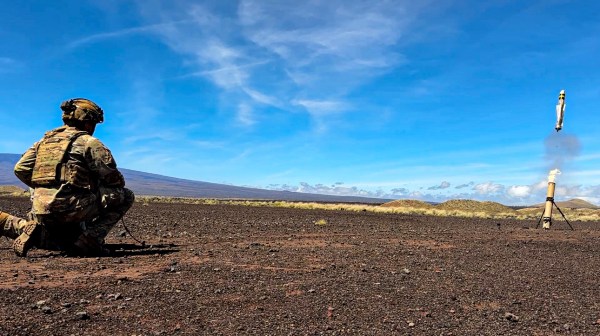Senate appropriators recommend ‘full funding’ for Replicator — and potentially even more money

The Senate Appropriations Committee approved a defense spending bill for fiscal 2025 Thursday that would provide “full funding” for the Pentagon’s high-profile autonomous systems initiatives known as Replicator — and lawmakers raised the possibility that even more money could be allotted for the effort.
Pentagon officials have already secured roughly $500 million from Congress for fiscal 2024 to move forward with tranche one, and they requested an additional $500 million for fiscal 2025. Tranche one includes kamikaze drones, unmanned surface vessels and counter-drone systems. Defense Department leaders are expected to decide on their selections for tranche two capabilities soon, which could include additional platforms and supporting technologies such as command and control, artificial intelligence and other software that are intended to boost the overall effectiveness and collaboration of these systems.
A key goal of Replicator — a signature initiative of Deputy Defense Secretary Kathleen Hicks — is to field thousands of “attritable autonomous” platforms across multiple domains by August 2025 to counter China’s military buildup in a cost-effective manner.
“The Committee recommends full funding for Replicator funds requested in the fiscal year 2025 President’s budget request,” SAC members wrote in their report for the bill.
They also suggested there could be a further plus-up, possibly by diverting funds from the Rapid Defense Experimentation Reserve (RDER) — a signature initiative of Undersecretary of Defense for Research and Engineering Heidi Shyu — which lawmakers faulted for not showing more progress. The Pentagon requested $450 million for RDER in fiscal 2025.
“Additionally, the Committee understands that Replicator Tranche Two selections are forthcoming, and that the Department may seek congressional action to ensure additional funding for Tranche Two systems is included in the Department of Defense Appropriations Act, 2025. In anticipation of these emerging requirements, and in light of the Committee’s substantive concerns about the lack of results of RDER, the Committee recommends reallocating RDER resources into a Rapid Defense Innovation Reserve. The intent of this reallocation is to enable the Department of Defense to reassess the RDER concept and provide the Committee additional information on the most effective use of requested funds for fiscal year 2025, which may include continuing RDER efforts or accelerating Replicator Tranche Two systems, until such time as funds for these systems can be aligned in the appropriate appropriations accounts in future budget submissions,” according to the report.
The legislation would direct the secretary of defense to brief the congressional defense subcommittees about an assessment of these types of efforts that includes “a determination of whether the funding proposed in the fiscal year 2025 President’s budget request would be better allocated in support of alternative innovation concepts, to include Replicator.”
However, along with the appropriations committee’s recommendation to fully fund Replicator in fiscal 2025, lawmakers also raised concerns regarding doctrine, organization, training, materiel, leadership, personnel, facilities and policy — known as DOTMILPF-P in Pentagon parlance — as well as test and evaluation.
“The Committee believes that this comprehensive understanding and plan to address the DOTMLPF–P implications are critical to the initiative’s success and has apparently not yet occurred in full. Additionally, the Committee believes that selected programs would benefit from the development of robust test and evaluation master plans [TEMP] or similar test and evaluation [T&E] plans to ensure that concepts as envisioned are technically capable of meeting stated objectives,” they wrote.
Within 60 days of the enactment of the legislation, the deputy secretary of defense and vice chairman of the Joint Chiefs of Staff would need to brief lawmakers on the DOTMLPF–P and T&E plans for each system that’s been selected for Replicator.
The bill would also task the head of the Defense Innovation Unit (DIU) — a Silicon Valley-headquartered organization that’s playing a major role supporting Replicator — to work with technical leadership among the military services and the Pentagon’s director for operational test and evaluation, to ensure that T&E plans are “adequate” and “fully resourced.”
Defense Department officials have acknowledged the need for robust test and evaluation for Replicator capabilities and fleshing out DOTMLPF–P.
“The services lead on fielding at scale and organize, train and equip. Not [the Office of the Secretary of Defense] — not OSD. And so what’s really, really important is much beyond the technology and the widget, is what we call DOTMILPF — the doctrine, the training, the operations. Otherwise, it just doesn’t really matter,” Undersecretary of Defense for Acquisition and Sustainment William LaPlante said in May during a Senate Appropriations Subcommittee on Defense hearing.
That same month, DOD officials acknowledged that the Pentagon had a lot more work to do after securing funding in fiscal 2024 to move ahead with the first tranche.
“That includes continuing to refine the concept of operation and employment for these capabilities; accelerating the experimentation timelines for individual capabilities, but also the collective portfolio to make sure that we are adequately testing and experimenting the mass effects that that we hope to achieve,” a senior defense official said during a background call with reporters.
The fiscal 2025 defense appropriations legislation still has many steps to go through before its provisions become law. It must be passed by the full Senate, reconciled with the House version after conference, passed by both chambers of Congress and signed by the president.
Meanwhile, the Pentagon’s top watchdog just initiated an evaluation of the Replicator initiative.
The department’s Office of Inspector General issued a memo earlier this week to multiple DOD components about its plans for the effort.
“During the evaluation, our focus will be to determine the effectiveness with which the Services and Defense Innovation Unit selected capabilities for the Replicator Initiative to meet the U.S. Indo-Pacific Command’s operational needs,” an OIG spokesperson told DefenseScoop in an email shortly after the memo’s release.
The memo noted that the office may revise or expand the objectives of the assessment as it unfolds.
“As with all Inspector General reviews, we intend to cooperate fully and with expediency to support the Office of the Inspector General’s important work to ensure full accountability for the American taxpayer,” Pentagon spokesman and Hicks’ public affairs advisor Eric Pahon told DefenseScoop in an email.






